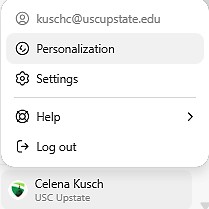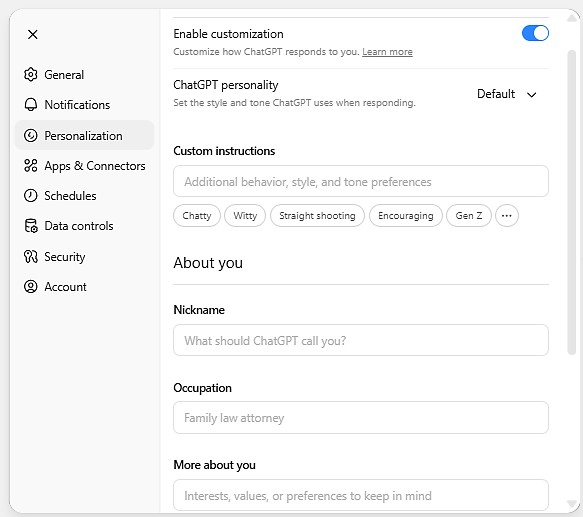
In the world of AI, context matters. A prompt that begins “I am a university professor teaching an undergraduate course…” will produce a completely different result than a prompt for a teenage superhero attempting to balance coursework with saving the world (AI-Generated Image).
If you find yourself repeatedly reminding ChatGPT.edu about your context or your response preferences, Custom Instructions may be a great solution for you. You can find Custom Instructions under the Personalization settings in your ChatGPT.edu account.

To customize your chat experience, you may wish to focus on two main areas of personalization: Custom instructions and More about you.
Custom instructions can guide the format, tone, and behavior patterns in chat responses, while More about you provides helpful context, interests, and perspectives you want the chat to prioritize in its responses.

Custom Instructions Examples
As you write your custom instructions, consider your distinct preferences:
- Do you usually want AI to summarize or shorten content? Do you want a list of bullet points with citations and links? Or do you want a thorough discussion in paragraph format for you to edit and streamline yourself?
- What voice would you like AI to use? Academic, formal, business-like, friendly, constructively critical, or in the USC Upstate brand style? Tailoring AI’s voice to the style of the output you want it to produce can save you time editing later.
- What behaviors do you want AI to start or stop? Do you usually want AI to produce sample content in a spreadsheet format or a Word document? Do you want AI to always pay attention to accessibility standards for headings in the documents it creates for you? Do you want it to skip its self-summary or refrain from reminding you that it is not a human? What behaviors can help you get the content you want faster and more efficiently?
- What details about your professional responsibilities and background experience should AI take into consideration? Are you a university instructor who primarily teaches introductory college courses with a focus on relevant real-world applications that can build students career skills? Do you teach advanced, research-focused courses where you like to introduce students to the current disciplinary debates in your field? Let ChatGPT take those preferences into account.
Here’s a sample for a instructor who teaches primarily online business courses:
Custom Instructions: Write in a professional but approachable academic tone. When creating instructional materials or assessments, ensure they are suitable for an asynchronous online learning environment and reflect sound educational design (e.g., measurable verbs, logical scaffolding, student-centered language). Whenever possible, tie in relevant case studies or scenarios that illustrate course content in business contexts.
More about you: I teach undergraduate and graduate business students online. My interests include instructional design, online pedagogy, and assurance of learning. I aim to make my courses engaging, outcome-driven, and relevant to real-world business practice. I value clear alignment among objectives, activities, and assessments.
Bonus Tip
If you wish to engage in a chat from a different perspective or with different preferences, just return to your personalization settings and toggle off “Enable customization.” Toggle customization back on when you are ready to return to your usual instructions.
You may also create multiple, labeled roles in the custom instructions, then signal which role you’d like AI to apply in a given chat by starting with “Adopt Role 1.”
Read more about ChatGPT Custom Instructions.
